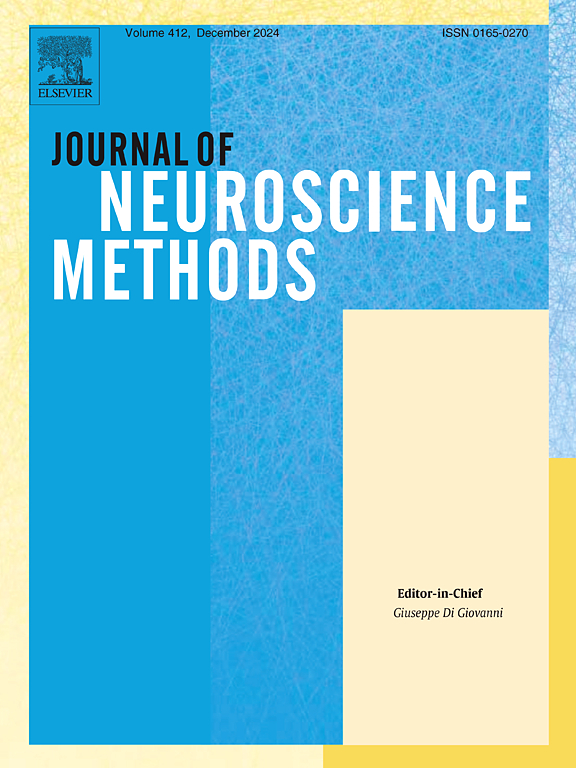Enhancing robustness of spatial filters in motor imagery based brain-computer interface via temporal learning
IF 2.7
4区 医学
Q2 BIOCHEMICAL RESEARCH METHODS
引用次数: 0
Abstract
Background
In motor imagery-based brain-computer interface (MI-BCI) EEG decoding, spatial filtering play a crucial role in feature extraction. Recent studies have emphasized the importance of temporal filtering for extracting discriminative features in MI tasks. While many efforts have been made to optimize feature extraction externally, stabilizing features from spatial filtering remains underexplored.
New method: To address this problem, we propose an approach to improve the robustness of temporal features by minimizing instability in the temporal domain. Specifically, we utilize Jensen-Shannon divergence to quantify temporal instability and integrate decision variables to construct an objective function that minimizes this instability. Our method enhances the stability of variance and mean values in the extracted features, improving the identification of discriminative features and reducing the effects of instability.
Results
The proposed method was applied to spatial filtering models, and tested on two publicly datasets as well as a self-collected dataset. Results demonstrate that the proposed method significantly boosts classification accuracy, confirming its effectiveness in enhancing temporal feature stability.
Comparison with existing methods: We compared our method with spatial filtering methods, and the-state-of-the-art models. The proposed approach achieves the highest accuracy, with 92.43 % on BCI competition III IVa dataset, 84.45 % on BCI competition IV 2a dataset, and 73.18 % on self-collected dataset.
Conclusions
Enhancing the instability of temporal features contributes to improved MI-BCI performance. This not only improves classification performance but also provides a stable foundation for future advancements. The proposed method shows great potential for EEG decoding.
通过时态学习增强基于运动图像的脑机接口中空间滤波器的鲁棒性
背景:在基于运动想象的脑机接口(MI-BCI)脑电解码中,空间滤波在特征提取中起着至关重要的作用。最近的研究强调了时间滤波对提取运动意象任务中的分辨特征的重要性。虽然很多人都在努力从外部优化特征提取,但从空间滤波中稳定特征的研究仍然不足:新方法:为解决这一问题,我们提出了一种方法,通过最小化时域的不稳定性来提高时域特征的稳健性。具体来说,我们利用詹森-香农发散来量化时域不稳定性,并整合决策变量来构建最小化这种不稳定性的目标函数。我们的方法增强了提取特征中方差值和均值的稳定性,提高了对鉴别特征的识别能力,降低了不稳定性的影响:结果:我们将提出的方法应用于空间过滤模型,并在两个公开数据集和一个自收集数据集上进行了测试。结果表明,提出的方法显著提高了分类准确率,证实了它在增强时间特征稳定性方面的有效性:我们将我们的方法与空间过滤方法和最先进的模型进行了比较。与现有方法的比较:我们将我们的方法与空间过滤方法以及最先进的模型进行了比较,结果表明,所提出的方法在 BCI 竞赛 III IVa 数据集上的准确率最高,达到 92.43%,在 BCI 竞赛 IV 2a 数据集上的准确率为 84.45%,在自收集数据集上的准确率为 73.18%:增强时间特征的不稳定性有助于提高 MI-BCI 性能。结论:增强时间特征的不稳定性有助于提高 MI-BCI 性能,这不仅能提高分类性能,还能为未来的进步奠定稳定的基础。所提出的方法在脑电图解码方面显示出巨大的潜力。
本文章由计算机程序翻译,如有差异,请以英文原文为准。
求助全文
约1分钟内获得全文
求助全文
来源期刊

Journal of Neuroscience Methods
医学-神经科学
CiteScore
7.10
自引率
3.30%
发文量
226
审稿时长
52 days
期刊介绍:
The Journal of Neuroscience Methods publishes papers that describe new methods that are specifically for neuroscience research conducted in invertebrates, vertebrates or in man. Major methodological improvements or important refinements of established neuroscience methods are also considered for publication. The Journal''s Scope includes all aspects of contemporary neuroscience research, including anatomical, behavioural, biochemical, cellular, computational, molecular, invasive and non-invasive imaging, optogenetic, and physiological research investigations.
 求助内容:
求助内容: 应助结果提醒方式:
应助结果提醒方式:


